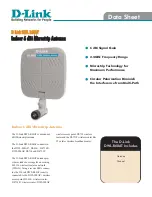
ME1310 Antenna and
Propagation (3D)
Lab 1 - 7/18
7. Use another RF coaxial cable to connect the
RF OUT
connector of the receiver module (Rx) to
the
RF IN
connector of the N9912A.
8. Adjust the distance between the antennas to
50 cm
and make sure that they are in the far-field
region. Record the distance and the heights of the antennas in the corresponding record form as
given in Appendix A.
9. Connect the Type A-to-Type B USB cable to the receiver module (RX) and PC.
10. Plugin the 5 V power adaptor to the receiver module (RX).
11. Connect the LAN cable to the Keysight N9912A FieldFox RF analyzer and PC.
12. Turn on the 5V power adaptor and Keysight N9912A FieldFox RF analyzer.
13. Open the RadPat v4 software. Click the
Settings
button and click
Connect
.
14. Set the start frequency to
2375 MHz
and the stop frequency to
2425 MHz
under the
RF
(Frequency Range
.
15. Set
Frequency of Interest
to
2400 MHz
. This is the frequency of the antenna-under-test (AUT).
16. Click
Configure
to enter the instrument setting configuration and click
Save & Exit
. This will bring
the rotator back to its home position and configure the N9912A settings.
17. After the homing operation and the N9912A configuration have completed, the window will return
to the RadPat v4 main interface and the
main panel
will be enabled.
Figure 5
– Main panel
18. Click
2D Radiation Pattern
, set the
Step Size
under the
Rotator Control
panel to
10 Deg/Step
and set the
Range Scan
from
0
to
350
degrees.
19. Click
Play
on the
main panel
to begin plotting the antenna radiation pattern.
20. After the plotting finished, click
Add
under the Marker panel to add a marker. You should see a
new entry of
Marker 1
added under the Marker panel. Triple-click on the row of the newly added
entry under the
Plot
column until a drop-down box appears. Then, select
Plot 1
to assign the
marker to the plotted radiation pattern.
21. Drag the marker to
Position (Degree)
0 using the mouse. Then, record the reading shown under
the Marker panel under the
dB
column into Appendix A. Repeat this step and increase the
position by 10 degrees until it reaches 350 degrees.
22. Determine the value of
max P
R
, based on the radiation pattern plotting, and calculate the
Normalized (dB)
value for each step.
NOTE
Normalized values can be calculated by dividing values with the
max P
R
.
23. Using the polar chart in Appendix A, hand plot the antenna radiation pattern and normalized data
recorded. Compare the hand-plotted antenna radiation pattern with the one plotted using the
RadPat v4 software.
24. Save the radiation pattern plot by clicking the
Save
button. A dialog box showing the file path of
saved plot should appear.
25. You may open the saved file (.csv file) using
Microsoft Excel
for further analysis.




































